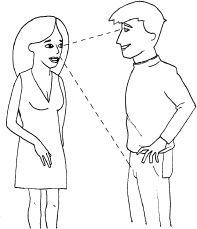The Definitive Book of Body Language (29 page)
Read The Definitive Book of Body Language Online
Authors: Barbara Pease,Allan Pease

Women's wider peripheral vision lets them appear to be looking in
one direction when they are, in fact, looking in another
When a woman wants to get a man's attention across a room she will meet his gaze, hold it for two to three seconds, then look away and down. This gaze is long enough for her to send him a message of interest and potential submission. An experiment by Monika Moore, PhD, of Websters University, showed that most men are not hardwired to read a woman's first gaze signal, so she usually needs to repeat it three times before the average man picks up on it, four times for really slow men, and five or more times for the especially thick. When she finally gets his attention she will often use a small version of the Eyebrow Flash that is a small, subtle eye-widening gesture that tells him the signal was intended for him.
Sometimes a simple face-to-face verbal approach of “Hey, I like you!” is more effective on men who are slow on the uptake.
As we said earlier, many people associate lying with looking away We conducted a series of experiments where participants
were told to tell a series of lies to others in recorded interviews. The recordings were used in our communication seminars where viewers were asked to judge who was lying and who wasn't. What we discovered was contrary to a popular belief about liars. Approximately 30 percent of the liars constantly looked away when they lied and the viewers spotted these lies around 80 percent of the time, with women having a better catch rate than men. The other 70 percent of the liars maintained strong eye contact with their victim, assuming they were less likely to get caught if they did the
opposite
of what people expected. They were right. Lie-catching dropped to an average of 25 percent, with men scoring a dismal 15 percent success and women 35 percent. Women's more intuitive brains were better than men's in detecting voice changes, pupil dilation, and other cues that gave the liar away This shows that gaze alone is not a reliable signal of lying and you need to observe other gestures, as well.
When a person's gaze meets yours for more than two thirds of the time, it can mean one of two things: first, he finds you interesting or appealing, in which case he'll also have dilated pupils; or second, he's hostile toward you and could be issuing a challenge, in which case the pupils will be constricted. As mentioned, women are good at deciphering pupil signals and can differentiate interest from aggression, but men are significantly worse at doing it. This is why the average man can't tell if a woman is about to give him a kiss or a slap in the face.
Most primates avert their gaze to show submission. If an ape is going to display aggression or is likely to attack, it will lock eyes onto its victim. To avoid being attacked, the victim will look away and try to make itself appear smaller. Scientific evidence shows that submission behavior appears to be hardwired into primate brains for survival reasons. Under attack, we make ourselves appear smaller by hunching our shoulders, pulling our arms in close to the body, pressing our knees together
and locking our ankles under a chair, dropping our chin to the chest to protect the throat, and averting our gaze by looking away. These gestures activate an “off switch” in the brain of the aggressor and the attack can be avoided.
Making yourself appear smaller turns off
the aggression switch in an aggressor's brain.
This is an ideal position to take if you are being reprimanded by a superior when you actually deserve the reprimand, but it would be detrimental against a random street attack. From a person who is walking past a group of possible assailants in the street it would signal fear and this can contribute to inciting an attack. If you walk upright with larger movements, swinging your arms and legs and having your front open, you will project that you could defend yourself if necessary and so are less likely to be attacked.
The Sideways Glance is used to communicate interest, uncertainty, or hostility. When it is combined with slightly raised eyebrows or a smile, it communicates interest and is frequently used as a courtship signal, mostly by women. If it is clustered with down-turned eyebrows, furrowed brow, or the corners of the mouth down-turned, it signals a suspicious, hostile, or critical attitude.
A normal, relaxed blinking rate is six to eight blinks per minute and the eyes are closed for only about one tenth of a second. People under pressure—for instance, when they are lying—are likely to dramatically increase their blinking rate. Extended
Blinking is an unconscious attempt by the person's brain to block you from their sight because they've become bored or disinterested or feel they're superior to you. It's as if their brain can no longer tolerate dealing with you, so their eyes shut for two to three seconds or longer to wipe you from sight and remain closed as the person momentarily removes you from his mind.

Shutting you out
Superior types may also tilt their head back to give you a “long look,” commonly known as “looking down one's nose;” this is also done by a person who feels that their importance is not being noticed. This is mainly a Western cultural gesture and a specialty of English people who feel they are upper class. If you see this happening during a conversation, it's a signal that you're not doing well and that a new tack is needed. If you believe the person is simply arrogant, try this: when they've closed their eyes for the third or fourth time, quickly step a pace to your left or right. When their eyelids lift again, it gives the illusion that you've disappeared and materialized in another place and this can really rattle them. If the person also starts snoring, you can safely assume that your communication has failed.
When the eyes dart from side to side it can look as if the person is checking out the activity in the room, but the reality is that the brain is searching for escape routes (just as happens in
monkeys and apes), revealing a person's insecurity about what is happening.
When you're with a particularly boring individual, your natural urge is to look away for escape routes. But because most of us are aware that looking away shows a lack of interest in the other person and signals our desire to escape, we look
more
at the boring individual and use a Tight-Lipped Smile to feign interest. This behavior parallels what liars are doing when they increase their eye contact to appear convincing.
The geographical area of a person's face and body that you gaze upon can also dramatically affect the outcome of a face-to-face encounter.
When you've finished reading this next section, try out the techniques we discuss as soon as possible—without warning anyone—and you'll experience the powerful effect these skills can have. It takes about a week of practice for these eye techniques to become a normal part of your communication skills.
There are three basic types of gazing: Social Gazing, Intimate Gazing, and Power Gazing.
Experiments into gazing reveal that during social encounters the gazer's eyes look in a triangular area on the other person's face between the eyes and the mouth for about 90 percent of the gaze time.
This is the area of the face we look at in a nonthreatening environment. The other person will perceive you as nonaggressive.

The Social Gazing area
When people approach each other from a distance, they look quickly between the other person's face and lower body to first
establish what the sex of the person is and then a second time to determine a level of interest in them. This gaze is across the eyes and below the chin to lower parts of the person's body. In close encounters, it's the triangular area between the eyes and the chest, and for distant gazing, it's from the eyes to the groin or below.
Men and women use this gaze to show interest in each other, and those who are interested will return the gaze. We usually give two quick glances and then look at their face and, despite most people's strong denials about it, hidden camera studies reveal that everyone does it, including nuns.
As we said earlier, a woman's wider-ranging peripheral vision, however, allows her to check out a man's body from head to toe without get ting caught. Male tunnel vision is why a man will move his gaze up and down a woman's body in a very obvious way. This is also the reason why men are constantly accused of ogling women's bodies at close range but women are rarely accused of the same, even though research shows that women do more of it than men. It's not that men are bigger oglers than women—men's tunnel vision means they keep getting caught.

The Intimate' Gaze zone

Women's wider peripheral vision means never getting caught; men's tunnel vision
means always getting caught
Looking down toward the ground during conversation serves different purposes for men and women. For a man, it lets him give a woman the once-over. For a woman, it has the dual purpose of letting her check him out and at the same time send a submissive signal of looking away and down.
Why do men have trouble making eye contact?
Breasts don't have eyes.
Imagine the person has a third eye in the center of their forehead and look in a triangular area between the person's “three” eyes. The impact this gaze has on the other person has to be experienced to be believed.
Not only does it change the atmosphere to very serious, it can stop a bore dead in their tracks. By keeping your gaze directed at this area, you keep the screws firmly on them.